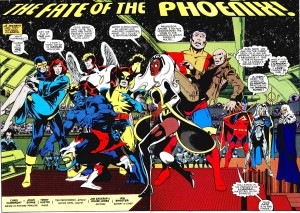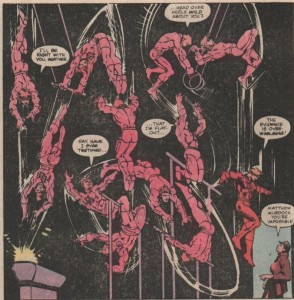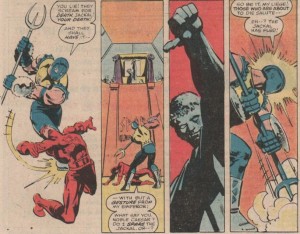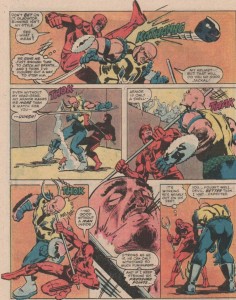To celebrate my impending thirtieth, I decided to take a look at the comics being published during the month of my birth, September 1980. Last week, I reviewed a handful of mostly disappointing DC titles. Will Marvel fare better?
Peter Park, The Spectacular Spider-Man #46
Writer: Roger Stern
Pencils: Mike Zeck
Inks: Bruce Patterson
Colors: P. Goldberg
I’m not a Spidey fan. Don’t get me wrong, I don’t hate him the way I hate Superman, but even as a kid, I never had any interest in the character. It’s not that his books are particularly bad. Nor are they any more or less formulaic than the average serialized adventure. I would like to say that the incessant self-pity grates, but that’s not true. I loved the X-Men, but all they did was whine about how the world didn’t appreciate their awesomeness.
My indifference to Spider-Man actually came from his place in Marvel’s shared universe. Now in theory, a shared universe is supposed to excite young readers with the promise of team-ups and crossovers and guest appearances. But there’s a flip side: all of Spider-Man’s adventures take place in a world that he shares with Thor, the Hulk, the Avengers, the X-Men, etc. In other words, he’s a small fry fighting two-bit villains.
The standard tag line I hear from Spidey fans is that Spider-Man is a middleweight hero who struggles to overcome more powerful foes, and that’s what makes him relatable. But young me didn’t care about relatable. I wanted his stories to be big and epic, I wanted them to “matter,” and how could Spider-Man foiling a bank robbery matter when the Avengers were saving the planet at the same time? As an adult, I can see that this attitude was silly. And yet … Spider-Man still seems like the sideshow to me.
In this issue, Spider-Man fought a jewel thief named Cobra. It’s as inconsequential as it sounds. Meanwhile, the X-Men were saving the universe…
Uncanny X-Men #137
Writer: Chris Claremont
Co-plotters: Chris Claremont and John Byrne
Pencils: John Byrne
Inks: Terry Austin
Colors: Glynis Wein
This is arguably the most famous issue in the history of the series. The star-spanning Shi’ar Empire comes to kill Jean Grey, a.k.a. the Phoenix, and the X-Men fight the Imperial Guard in a failed bid to save her. And since this was written by Chris Claremont, it begins with a crapload of exposition.
Jack Kirby created the Watcher way back when in the pages of Fantastic Four. From what I’ve read, the Watcher is a near-omnipotent entity who’s grand purpose is explaining the plot to lesser beings. He’s essentially a glorified recap page, and yet he narrates with such gusto. Look at the guy! He takes such pride in summarizing the preceding six issues, and he’s already convinced me that that this will be the greatest comic ever. Who knew that combining a giant bald head, a toga, and goofy boots would produce such a charismatic character? Jack Kirby knew, that’s who.
John Byrne drew a great double-paged opening splash. He fit all the characters onto the spread while still leaving just enough room for Claremont to give more lines of exposition to as many characters as possible. That’s teamwork.
Of course, the subtext of the storyline is still depressing. A woman gains absolute power, so naturally she goes insane and has to be destroyed. Rumor has it that Byrne and Claremont initially intended to de-power Phoenix as a punishment for her actions, but Editor-in-Chief Jim Shooter insisted that she die (because she’d committed genocide in an earlier issue). Regardless of their intentions, de-powering doesn’t change the subtextual problems.
Not that any of this mattered to my younger self. The sprawling melee on the moon remains one of my favorite action pieces from superhero comics. And the death of Jean Grey perfectly embodies why so many kids and teens were drawn to the X-Men: MELODRAMA.
The romantic (and platonic) relationships and the overwrought drama were the main appeal of the book and what set it apart from its more traditional competitors. Of course, as time passed, the relationships became increasingly byzantine, to the point that a new reader would need a flow chart to understand who’s related to who. But in 1980, it was still crying and yelling and angst and Wolverine getting clobbered every other issue. It was a good time.
Fantastic Four #222
Writer: Doug Moench
Artists: Bill Sienkiewicz and Joe Sinnott
Colors: G. Roussos
In a few years, Bill Sienkiewicz would do incredible work at Marvel, becoming one of the few mainstream artists to reject the realist paradigm. But in 1980 he was another genre hack, cashing a check on the Fantastic Four. This splash page is just sad (and somewhat creepy).
The plot downplayed the usual sci-fi nonsense in favor of seances and demon-possessions. It’s not a bad issue, truth be told, even with the disappointing art.
But Fantastic Four is one of those books that I can only enjoy intermittently. The family dynamic is supposed to be it’s main appeal, but I generally find the relationship of Reed Richards and Sue Storm to be tiresome. And adding the kid didn’t win me over. Maybe I’m one of those singles who doesn’t care about the trials and tribulations of married couples.
On the other hand, I liked The Incredibles, which is more or less a knockoff of the FF family. And if I had to pick the most significant difference between The Incredibles and the Fantastic Four, it would be in how they treated the super-kids. In the former, the children are revealed to be a heroes just like their parents. Without their help, Mr. Incredible could never have saved the day. But in Fantastic Four, Franklin is more a burden than a person. He’s always getting possessed or losing control of his powers or something equally terrible and his parents have to constantly worry about his well-being. Family life seems like a cross to bear, rather than a blessing. Why would I want to read a superhero comic about that?
Avengers #199
Writer: David Michelinie
Pencils: George Perez
Inks: Dan Green
Colors: Jim Salicrup
This a great example of how hindsight can ruin my appreciation for a perfectly decent comic. There’s nothing wrong with this issue, in itself. Michelinie may be a hack, yet he knows how to pace a story and he at least gives the characters distinct “voices.” But the real star of the show is George Perez. He takes a generic heroes vs. robot storyline and crafts several exciting action sequences. Plus, I love the anime-inspired design for the robot, Red Ronin.
What ruins the issue for me is the sub-plot leading to the next issue, Avengers #200. A quick summary: the heroine Ms. Marvel is pregnant without a father and the fetus is growing rapidly. In the next issue, the storyline will go from vaguely unpleasant to outright disgusting when the baby is born and rapidly ages into the very man who impregnated her (I’ll let old-school fangirl Carol Strickland explain the gory details). It’s one of the most offensive and ill-conceived storylines I’ve ever seen in a mainstream comic (and I was reading comics in the awful ’90s).
Quality craftsmanship is all well and good, but it can’t hide the fact that many of the people creating these comics were creeps.
Daredevil #166
Writer: Roger McKenzie
Co-plotters: Rober McKenzie and Frank Miller
Pencils: Frank Miller
Inks: Klaus Janson
Colors: Glynis Wein
I’m no good with dates. I didn’t realize Frank Miller was working on Daredevil all the way back in 1980. He had to share writing credits with McKenzie, but the issue is full of unmistakable Millerisms, especially the tough-guy dialogue and the hard-boiled narration inspired by Raymond Chandler.
Miller was also drawing these early issues, and it’s an interesting sample of his early work.
As the image above makes clear, Miller loved to display Daredevil’s physical prowess. Much of the comic is hardly distinguishable from any other mainstream title, but the action sequences easily stand out as some of the best from the era.
I’m not going to claim that Miller is a brilliant artist (he isn’t), but he understands and appreciates violence in a way that few superhero artists do. That may sound like a criticism, but we’re talking about a genre characterized by violent confrontation, and it’s always amazed me that so few artists really understand or care about the anatomy of a fight sequence. For Miller, a cursory exchange of punches would never suffice. There’s a give and take between equally matched opponents, weaknesses are sought, and ineffective strategies are replaced.
There’s also a realism to Miller’s violence, though it’s not necessarily graphic in nature (this was still the era of the Comics Code). Miller’s characters “sell” the blows, every hit looks painful, and the characters strike each other in ways clearly intended to cause serious harm.
It’s easy to see why Miller’s work became a success. Compared to Daredevil, the other comics I reviewed seem hesitant and even cowardly in their use of violence. The superhero publishers relied on violence to gain the attention of young boys, but it was always within strict limits. The superhero books were supposed to be morally uplifting. But Miller didn’t see violence as a mere tool to sell a book about selfless heroism. Instead, heroic violence was the whole point. Morality is all well and good, but most superhero readers aren’t looking for role models. They’re looking for cheap thrills, and there are few things as thrilling as seeing one man savagely pummel another.
_________________
And that brings my exercise in nostalgia to an end. Marvel’s September 1980 line-up was fairly impressive in terms of craft, even though it lacked the genre variety of DC Comics. However, when I read all these comics together, it’s obvious why Marvel could never attract female readers.









“Relatable” is not a word. Or, if it is, it shouldn’t be. It always grates on me like chalk on a chalkboard. Rather than saying “X character is “relatable,” we should dangle our prepositions and say, “X character is easy to relate to…” Grammatically correct would be, I guess, “X character is one to which the reader relates…,” but I’m willing to settle.
I know this tirade is largely irrelevant–but I had to get it off my chest.
Blogging about old comics is largely irrelevant too, so you don’t need to apologize over grammar tirades.
You’ll be happy to know that WordPress agrees with you-it underscored “relatable” as a misspelled word. I used the word anyway, because I will not be held down by your rules and regulations.
Actually, there’s nothing wrong with dangling prepositions. I think even Fowler says it’s fine.
Over-correction; it is a blight.
I would’ve thought actually that if any Marvel/DC title was going to have a female audience, it would have been the x-men. Lots of female characters, an effort with Kitty to try for the YA demographic…I don’t know, they could have done worse. That feminist writer you linked to seems to have had some respect for Claremont….
That’s a fair point, and X-Men does seem to have a considerable number of female fans (though I doubt the gender split among fans is 50:50). In any case, I was thinking more in line-wide terms.
Claremont earns some bonus points with me because of Avengers Annual #10. The story consists of Ms. Marvel reading the riot act to the Avengers for abandoning her in her time of need. But it’s not hard to read between the lines and see that Claremont was criticizing Jim Shooter and everyone involved in Avengers #200. Ms. Marvel was one of his pet characters.
Boy oh boy. I myself was 16 when that issue of X-MEN came out, at a point where I had shed every comic habit EXCEPT for X-MEN and DAREDEVIL, and you can plainly see why. Turns out I knew what I was doing.
A few years later I discovered LOVE AND ROCKETS and AMERICAN FLAGG! and NEXUS, on my way to becoming a snotty alt-comics nerd. Nowadays I will read pretty much any superhero comic for fun EXCEPT X-Men. And so we come full circle…
Sorry to interrupt the discussion, but what’s your email John E?
You seem vaguely familiar.
jwilliams76@verizon.net
Now DON’T INTERRUPT
John – I don’t read many superhero comics anymore (not with any regularity, anyway) but I completely understand your hostility toward X-Men. That comic really is the poster child of drowning in one’s own continuity.
I should probably check out American Flagg at some point…
Geeze. I was 26 in September 1980 and wondering whether I shouldn’t give up comics altogether, as a responsible adult.
30 years later, here I am. Pathetic, I know.
Good to remind us all that Frank Miller was damned good at what he did before he became FRANK MILLER.
I loved, at the time, the sheer perversity of that Avengers 200.
In X-Men, not only did Shooter insist that Jean Grey die, he did it after Byrne had penciled an issue in which Jean’s punishment was to be regressed to mental childhood. I’ve seen the pencils, in the early ’80s fanzine ‘Comics Feature’.
Byrne later conceded that Shooter’s ending was better. Byrne gets a lot of derision, but I’ll concede that he’s one of the few cartoonists out there who’ll freely admit to screwing up; for example, he has stated that his elimination of Superboy and Krypto from his 1980’s Superman reboot was a mistake.
1980 was an interesting year: newsstand sales were dying and the direct market hadn’t taken over yet.
Richard,
I’d say my superhero reading is limited to maybe 6-8 comics a year, which is a pretty big deal considering a decade ago I wouldn’t even look at the things. (Right, Charles?)
Not wanting to wax nostalgic, but my boredom with everything Marvel and DC dovetailed nicely with the rise of the direct market (in my case, circa 1983) when companies like First and Eclipse started putting out weird and wonderful stuff like FLAGG, Baron & Rude’s NEXUS, Moench & Day’s AZTEC ACE, Englehart & Leialoha’s COYOTE, and even Pasko & Staton’s revamp of E-MAN. I was spoiled; I had not one but two Heroes World retail shops near me and it was one helluva great summer. (Add to that the release of R.E.M.’s “Murmur” and you had all the ingredients for the furtherance of my cultural growth.)
I’m sure AMERICAN FLAGG! probably reads a little dated now, but the first 10 or so issues are definitely worth checking out.
And they’ve just been re-mastered in a new collected edition; they were brilliant.
Oh, I almost forgot: in the 80s some no-name comics company (ahem) put out a book called THE X-MEN COMPANION, which featured a fairly blunt interview with Chris Claremont, wherein he angrily decried the events of that Avengers comic. He was especially appalled by the way the other Avengers were depicted, reacting to Ms. Marvel’s condition with oohs and ahhs and offering to knit booties and babysit. He made no bones about what a shitty book it was.
I can say from experience that women fans LOVED the X-Men back then. Also the new Teen Titans, for similar reasons. (Just ask Heidi McDonald.) But I think that was about it.
BTW, that Claremont Avengers annual features the most stunning superhero art Mike Golden ever produced, inked by Armando Gil…
We get to see Ms Marvel bitchslap Thor, to boot!
And the fight I’d been waiting for: Vision vs Blob! (You see,both the Vision’s android frame and the Blob’s mutant power control weight and density, so when the two…uh…
Heh.)
Nerd.
Alex- thanks for the background info on the Claremont/Byrne/Shooter situation.
Lobotomizing Jean would have been less dignified than a death scene … on the other hand, it would have been in keeping with the X-Men soap opera. I can just imagine Cyclops’ whining and angst as his girlfriend spends all day drooling on herself.
I always though Claremont had some similarities to William Marston (creator of Wonder Woman). Marston was the more ambitious and intelligent creator, but both men idealized/fetishized powerful women.
Well, since you ref’d E-Man…They did a great X-Men parody, with Claremont as Ford Fairmount, and Stan Lee as Stanley Presents.
I remember a great panel where ultra-Feminist Fairmount cringes before Ororeo, the Storm parody:
“What do I have to cut off?”
Yeah, I was going to mention that X-Men Companion interview too, re: Avengers 200. I remember Claremont says something like “before Shooter redid it, not that the original was any better.” So I guess the story had to be redone because it wasn’t misogynist _enough_?
Not sure I ever noticed that the disposal of Phoenix and Ms Marvel happened only 1 month apart. I’m sure that must have looked creepy at the time…